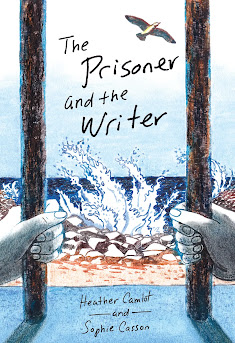The Prisoner and the Writer is a beautiful book – beautifully
written, beautifully illustrated – and what writer can fail to be inspired by
the story of Émile Zola and Alfred Dreyfus? Yet
for me the book was also a disappointment.
Alfred Dreyfus was a French military officer falsely
accused and convicted of spying for Germany. Zola was a renowned author and he
took on Dreyfus’s case, writing the most famous newspaper article of all time “J’Accuse!”
which accused the French military of persecuting Dreyfus solely because he was
Jewish.
Beyond that, the purpose of Zola’s article was to force
the French military to take Zola to court for libel so that, in court, Zola could
show up the case against Dreyfus as the lie it was. A ballsy move – that
resulted in the antisemitic French courts convicting Zola of libel and him fleeing France
to avoid prison.
Thanks to Zola and the widespread efforts of many in
France, Dreyfus was eventually freed from his prison on Devil’s Island, pardoned,
and awarded the Legion of Honour.
This is the story told in Heather Camlot’s picture
book recommended for children aged 9 to 12. Written in free verse, the book brings
out the emotion of the story, while Sophie's deft illustrations suggest both the emotion of
the story and the historical era.
This surely is a story everyone should know – about a
writer lending his pen to a fight for justice and against prejudice – and doing
so at great personal risk to himself. Indeed, it’s suspected that Zola’s eventual
death from smoke inhalation was no accident – that an anti-Dreyfusard had
blocked his chimney in order to murder him.
 |
| Heather Camlot |
But I cannot help but mourn that the most significant historical
effect of the Dreyfus Affair is missing from Camlot’s story and her Afterwards:
Theodor Herzl, the father of modern Zionism, said it was the Dreyfus Affair
that convinced him that Jewish life in Europe was a dead-end – that the only
hope for Jews was for us to create our own state.
Tragically, Herzl was right. The triumph of the Dreyfusards
in France did not mean the end of French antisemitism. Some decades later when
the Nazis occupied France, there were plenty of French citizens to assist the
Nazis in shipping Dreyfus’s granddaughter Madeleine Levy, along with tens of thousands of other French Jews, to Auschwitz
to be gassed to death.
In her Afterward, Camlot voices her fears of resurgent
antisemitism. It’s a fear many of us share. She also speaks of her hope: “When
I see antiracism protests sweeping the globe, Queer-Straight alliances in
schools, growing expectation that the diversity of the population should be
represented at the highest level of government – when I see people standing up
and speaking out – I have hope. “
Alas, I can’t share this hope. I see an antiracism movement that itself slides into antisemitism, with the leadership of the Black Lives Matter movement wanting to remove the world’s only Jewish state from the map (see here and here for starters). And I see a “diversity, equity, and inclusion” industry that excludes Jews, that singles out Israel and Jews who support Israel for condemnation, and descends into outright antisemitism (see here, here and especially here for starters). The lessons of the Dreyfus Affair do continue to resonate, but those lessons haven’t yet been learned.
The Prisoner and the Writer is a book worthy of a place on people’s bookshelves. But what the Jewish community needs – and is not getting – are kids’ books that speak to the danger of antisemitism and Israel-hatred on the left.
***
Brian Henry is a writer, editor,
creative writing instructor, and publisher of the Quick Brown Fox blog. He reviewed
books for Books in Canada and The Toronto Star and has written
opinion pieces for the National Post and the Toronto Star. He was
also a regular contributor to the (now defunct) Jewish Tribune and the
Engage and Harry’s Place websites in the UK.



No comments:
Post a Comment
Note: Only a member of this blog may post a comment.